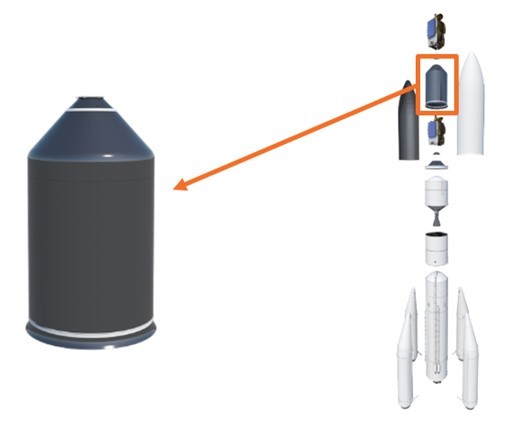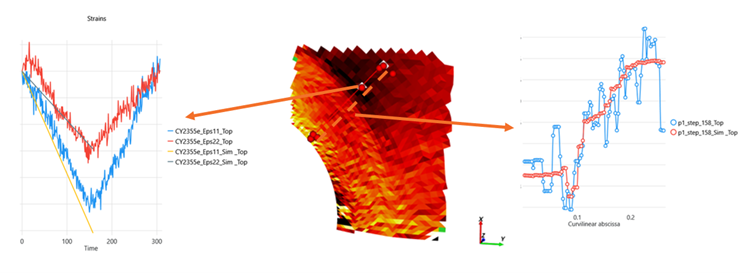

Simulation and Experimental Collaboration of Ariane 6 Launcher: Comprehensive Verification Strategy for Dual Launch Structure
Release time:
2024-11-28 17:27
Source:
Ensuring the credibility of simulation models is a key focus across all engineering fields. In aerospace engineering, structural identification is a critical step to ensure that key components can withstand the most severe operating conditions. This process is vital for ensuring the safety and reliability of the system during the mission. This article focuses on the identification of the dual launch structure (DLS) of the Ariane 6 launch vehicle developed by ArianeGroup. The certification aims not only to verify the structure itself but also to confirm that the numerical simulation model used can reliably predict the behavior of the structure, thereby minimizing reliance on future physical testing.
The aerospace industry largely relies on simulation models to predict the behavior of complex systems under different conditions. Accurate models can reduce the need for extensive physical testing, saving time and money. The Ariane 6 developed by ArianeGroup is designed to meet the demands of a competitive space market, offering configurations such as Ariane 62 and 64 to accommodate different payloads. One of the core elements of its design is the dual launch structure (DLS), which will inevitably endure significant stress during the launch.
Ariane 6is designed to provide a multifunctional and cost-effective solution for space launches. The DLS plays a crucial role in this system, supporting the payload throughout the launch process and ensuring structural integrity. Therefore, its certification is an important phase in the development of the launcher. At the same time, the validation of the DLS simulation model must confirm that the model can reliably predict the performance of the structure under various load conditions, thereby minimizing the need for extensive physical testing in future designs.

Ariane 6Schematic diagram of the DLS structure on the launcher
ArianeGroupprovides the expertise and infrastructure necessary for comprehensive static testing, which is crucial for assessing the DLS's response to axial, bending, and lateral loads.

DLSDescription of the structural testing validation process
EikoSimand ArianeGroup's collaboration aims to add a validation process that directly integrates experimental and simulation methods for certification. EikoSim contributes significantly to the collaboration by utilizing its expertise in digital image correlation (DIC) to measure surface displacements and deformations of instrument components. The innovative measurement methods brought by EikoSim complement traditional point measurement techniques, providing a more complete view of structural responses.
The identification process based on the testing pyramid method ends with a level 1 test at failure, which combines various stresses and can determine the actual resistance range. Basic loading is performed first. For each load (axial, lateral, etc.), the stiffness of the DLS and its ability to withstand the design limit loads are assessed.
The application of instruments during the data collection process is very important. Approximately 200 strain gauges are placed at strategic locations to measure the level of deformation in the structure. These strain gauges provide point data on the internal strain distribution of the DLS. Additionally, about 30 displacement sensors are used to provide information on global deformation patterns. Rayleigh backscattering fiber optic sensors are also used to provide continuous data on deformation along the fiber, improving the resolution and accuracy of deformation measurements.
Finally, digital image correlation (DIC) plays a crucial role in the validation process. Three DIC systems are deployed in key areas identified by preliminary finite element analysis, supplemented by marker tracking measurements.

Supplementary test results: strain gauge measurements (left), digital image correlation measurements (middle), and fiber optics (right).
EikoSimA data fusion environment has also been developed to integrate complementary measurement data. The comparison between finite element predictions and experimental data shows a high degree of correlation, with deviations typically within acceptable ranges.
For example, the strain measurement results in key areas show deviations from predicted values of less than 20%, which is acceptable at this stage for structural validation purposes. Analysis of these deviations indicates that they are primarily due to model simplifications or slight inaccuracies in measurement equipment. For instance, nominal (unregistered) boundary conditions and slight differences between assumed material properties in the model and actual properties can explain some of the discrepancies observed in the deformation data.
The consistency between the finite element model and experimental results enhances the credibility of the simulations, confirming their relevance to future predictive analyses. This validation also serves as a basis for improving the model, such as by adjusting boundary conditions to better align with observed data.

FEM/DICSchematic comparison: finite element simulation results (left), digital image correlation measurements (middle), and deviation mapping (right).
This project embodies the concept of "smart testing," where simulation and physical testing are not only complementary but also mutually reinforcing. Preliminary simulations guided the design of the test fixtures, ensuring that critical load paths and potential failure points were adequately monitored. The physical test fixtures were optimized based on finite element method results to closely match the expected operating conditions of the DLS. The integration of DIC data with traditional measurement techniques provides a comprehensive view of DLS behavior, enhancing confidence in the simulation results.
In the future, the focus will be on refining the finite element method validation process, including the development of more complex validation measurement methods. These measures will be able to quantify the credibility of simulation models more precisely and identify specific areas that need improvement.
Additionally, efforts will be made to implement an automated model optimization process that can adjust model parameters based on experimental data, further improving the accuracy and reliability of the models.
Reliability verification of simulation models,DIC Strain Measurement,Simulation and Experimentation Collaboration,EIKOTWIN DIC,Non-contact strain measurement

